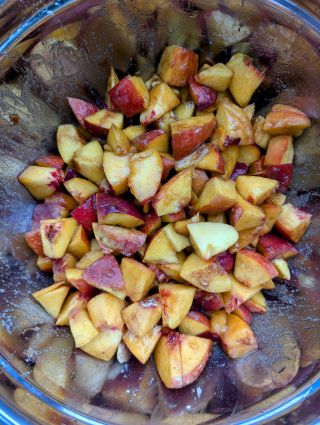Relationships
3 Ways to Keep Romance Sweet This Summer
After finding romance, accentuate the peachiness and decrease the pitfalls.
Posted August 2, 2024 Reviewed by Tyler Woods
Key points
- With mutuality, there’s a healthy give and take in a relationship over time.
- In fighting fairly, a couple shares different views, working through them while hearing each other.
- As you plan your next summer romance date, you might want to make our summer peach cobbler.

Perhaps you’ve found a summer romance. Or maybe you’re still out there looking. Summer romance can be wonderful—but heartache can loom as well.
Once we find that moving, sweet romance, how can we accentuate the peachiness and decrease the pitfalls?
How can we cherish our relationships, engaging in ways that help them work?
As we move into August, I’m reminded of a plane ride years ago when recently engaged. This was a time in life when I talked with anyone and everyone about engagements. The excitement was infectious. It suddenly seemed like everyone was engaged, until one conversation shook me to the core, staying with me to this day.
It was a work trip, traveling after yet another trek to Macy’s, where Julian and I continued our wedding registry disagreements. For this last visit, the struggle was (embarrassed to say) about plates. Julian wanted plain plates. No design, no texture. As a chef, he was adamant that the food was the décor that adorned the plate. For me, it was about patterns. No design was too much. In fact, the more design, the better.
This was our third visit. We were at an impasse. The people who worked on the registry floor were getting to know us. Perhaps not a great sign. Undecided and with a deadline looming, we took the elevator down to street level yet again.

But back to that flight. Being engaged was a beacon for attracting other engaged people. So it happened that the passenger sitting next to me was recently engaged. He oozed knowledge and confidence about wedding planning. This was a second marriage, he explained, so he knew how it worked. I was fascinated to learn more.
“Isn’t deciding what to put on your registry difficult?” I asked.
“Nah,” he said. “I’ve done this before. This time, I told my fiancée to pick out whatever she wants for the registry. Whatever her heart desires. Then after the wedding I’ll just return whatever I don’t like.”
“Yikes!” my internal voice jolted. I felt so bad for the unknowing fiancée, selecting what she loved with no clue it might all be returned. Her registry effort was leading down a potentially cobbled path of invalidation and disappointment, ultimately feeling left alone with the hope of choices.
My inner dread shifted to gratefulness. Suddenly, three trips to Macy’s didn’t seem that bad. Heck, maybe it was even healthy. There were no hidden “return the registry” agendas. Just drawn-out conversations that I was now beginning to think were practice for larger heart-to-hearts we would undoubtedly have as our lives together unfolded.
I had an urge to call Julian when we landed.
I’ve never forgotten that story. It’s one I share in couple and family therapy classes when we talk about qualities of health and unhealth in relationships. As you move forward with your summer romance, consider some of the ideas below. Take what works for you and leave the rest.
And the resolution to the plate debate is just before the recipe.
Mutuality Is Key
Not everything can be equal in a relationship all the time. Sometimes you might give more, sometimes it’s your partner. But with mutuality there’s a healthy give and take in a relationship over time that tends to even things out or help us feel that way.
Mutuality in relationships means there’s a shared trust where each person is committed to contributing to the well-being of the relationship in ways they can. It’s also a shared understanding and acknowledgment that none of us can get it right all the time. With mutuality, it’s about trying to do our best to be there for our person.
We are imperfectly committed to a shared partnership.

Fighting Fairly: Tricky but Important Business
Clients and I often talk about fighting fairly in a relationship. Fighting fairly refers to how couples can share different views, working through them to voice differences while hearing each other.
Fighting fairly does not refer to a domestic violence situation where someone is being abused. Rather, it’s about how couples can discuss complicated differences that are a natural part of being with someone over time; differences about how to raise children, where to live, managing time, finances, and many more.
My personal perspective is that it’s important and natural to have disagreements. “But they never fought,” is a common statement shared by adult clients whose parents divorced when they were kids. Sometimes, when we don’t have difficult conversations with our partners, the feelings around what we really want to say fester and boil.
Fighting fairly involves taking turns to share your perspective, actively listening to each other, seeking compromise when possible, and agreeing to disagree when common ground can’t be found.
You vs. I Statements
“You don’t listen to me.”
“I feel like you’re not listening.”
If someone said either of these statements to you, which would feel better, the first or the second? The Gottman Institute talks about “I” vs. “You” statements. With “I” statements, we can authentically express ourselves while also decreasing defensiveness.
We can actually get more of what we want from our relationships when we use “I” statements because they help keep communication open.
Cooking Couples
Our book, Eating Together Being Together (Clauss-Ehlers & Clauss-Ehlers, 2022), is all about building connections with people through cooking.
As you plan your next summer romance date, you might want to make our summer peach cobbler. It’s fresh, sweet, and delicious, just like summer romance.
Oh, right. So, what happened with our registry? We registered for white dinner plates to feature Julian’s food and very decorative accent plates to add design when needed. My best friend bought every single one of those accent plates!
Summer Peach Cobbler

INGREDIENTS, FILLING
8 ripe peaches (pitted, sliced and cut into ½ inch pieces)
⅓ cup brown sugar
⅓ cup white sugar
¼ teaspoon ground cinnamon
¼ teaspoon salt
Zest of 1 lemon
2 teaspoons cornstarch
INGREDIENTS, TOPPING
1 ½ cup AP flour
⅓ cup white sugar
⅓ cup brown sugar
½ teaspoon salt
1 ½ teaspoon baking powder
8 tablespoons sweet butter (chilled and chopped)
⅓ cup milk
INGREDIENTS, SPRINKLES
1 teaspoon ground cinnamon
2 tablespoon white sugar
SERVES 8
DIRECTIONS
Preheat the oven to 425 F.
In a large bowl, gently mix all the ‘filling’ ingredients together. Place the fruit mixture into a 2-quart ovenproof dish and bake in the preheated oven for 10 to 12 minutes. Remove from the oven and set aside.

While the peaches are in the oven, In a large bowl, mix the AP flour, ⅓ cup white sugar, ⅓ cup brown sugar, the salt and baking powder together. Add the butter, and with the tips of your fingers incorporate the butter into the flour mixture, until it becomes crumbly. Now add the milk and lightly mix, until the batter comes together.
Spoon on dollops of batter evenly all over the top of the warmed peach mixture (remember the name cobbler comes from it resembling a cobbled street).
In a small bowl, combine 1 teaspoon of cinnamon with 2 tablespoons of sugar and sprinkle over the entire cobbler.
Return the baking dish to the hot oven for approximately 30 minutes or until the topping has turned a golden brown.
Remove from the oven, spoon out some generous portions onto individual plates and serve with a scoop or two of your favorite ice cream, gelato, or frozen yoghurt.
Delicious and heartfelt.
References
Clauss-Ehlers, J.C.E., & Clauss-Ehlers, C.S. (2022). Eating together being together: Recipes, activities, and advice from a chef dad and psychologist mom. Princeton Architectural Press.




